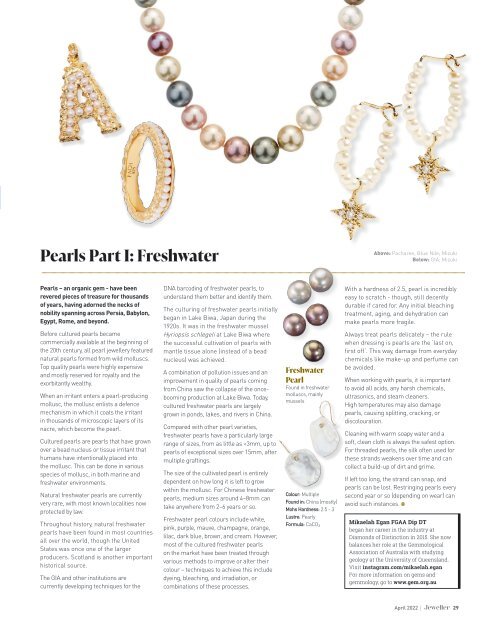Jeweller - April 2022
Diamond disruption: How the Russia-Ukraine conflict is changing global trade High time for change: Where to for watch brands after Baselworld? Darkness & light: Uncover the mysteries of black and white gemstones
Diamond disruption: How the Russia-Ukraine conflict is changing global trade
High time for change: Where to for watch brands after Baselworld?
Darkness & light: Uncover the mysteries of black and white gemstones
You also want an ePaper? Increase the reach of your titles
YUMPU automatically turns print PDFs into web optimized ePapers that Google loves.
Pearls Part I: Freshwater<br />
Above: Pacharee; Blue Nile; Mizuki<br />
Below: GIA; Mizuki<br />
Pearls – an organic gem - have been<br />
revered pieces of treasure for thousands<br />
of years, having adorned the necks of<br />
nobility spanning across Persia, Babylon,<br />
Egypt, Rome, and beyond.<br />
Before cultured pearls became<br />
commercially available at the beginning of<br />
the 20th century, all pearl jewellery featured<br />
natural pearls formed from wild molluscs.<br />
Top quality pearls were highly expensive<br />
and mostly reserved for royalty and the<br />
exorbitantly wealthy.<br />
When an irritant enters a pearl-producing<br />
mollusc, the mollusc enlists a defence<br />
mechanism in which it coats the irritant<br />
in thousands of microscopic layers of its<br />
nacre, which become the pearl.<br />
Cultured pearls are pearls that have grown<br />
over a bead nucleus or tissue irritant that<br />
humans have intentionally placed into<br />
the mollusc. This can be done in various<br />
species of mollusc, in both marine and<br />
freshwater environments.<br />
Natural freshwater pearls are currently<br />
very rare, with most known localities now<br />
protected by law.<br />
Throughout history, natural freshwater<br />
pearls have been found in most countries<br />
all over the world, though the United<br />
States was once one of the larger<br />
producers. Scotland is another important<br />
historical source.<br />
The GIA and other institutions are<br />
currently developing techniques for the<br />
DNA barcoding of freshwater pearls, to<br />
understand them better and identify them.<br />
The culturing of freshwater pearls initially<br />
began in Lake Biwa, Japan during the<br />
1920s. It was in the freshwater mussel<br />
Hyriopsis schlegeli at Lake Biwa where<br />
the successful cultivation of pearls with<br />
mantle tissue alone (instead of a bead<br />
nucleus) was achieved.<br />
A combination of pollution issues and an<br />
improvement in quality of pearls coming<br />
from China saw the collapse of the oncebooming<br />
production at Lake Biwa. Today,<br />
cultured freshwater pearls are largely<br />
grown in ponds, lakes, and rivers in China.<br />
Compared with other pearl varieties,<br />
freshwater pearls have a particularly large<br />
range of sizes, from as little as


















